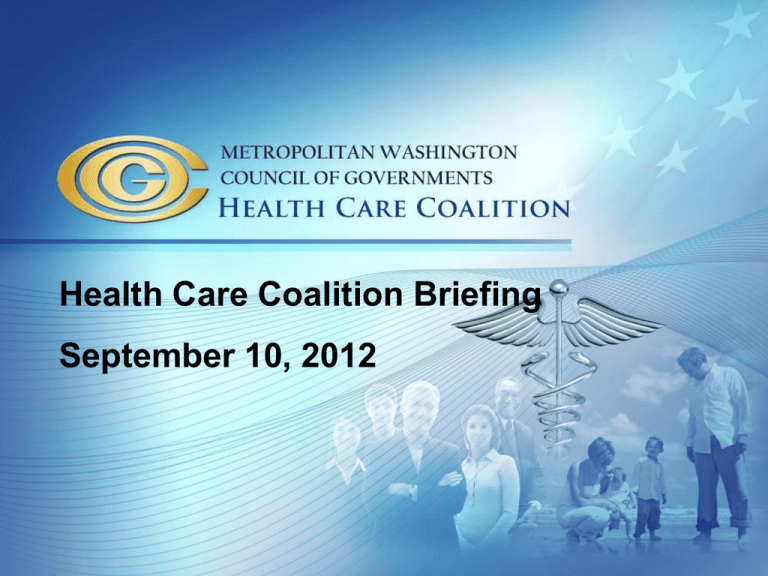Health Care Coalition Briefing September 10, 2012
advertisement

Health Care Coalition Briefing September 10, 2012 ABOUT THE COALITION • • • • • • History of the Health Care Coalition Advantages of the Health Care Coalition 2012 Medical Plan Renewal Process – Cost Savings for this Year 2011 Benchmarking -Medical and Prescription Drug Plan Design Setting Up a Coalition is This Right For You! Open Forum/Q & A 1 History of the COG Health Care Coalition • In 1990, the Metropolitan Washington Council of Governments Board authorized COG to sponsor a health care benefit program. • Purpose: to purchase and manage the provision of health benefits for jurisdictions/organizations associated with COG. 2 Coalition Member Involvement The Coalition representatives: • Take an active role in plan design, requests for proposals and rate negotiations • Collectively purchase consulting services • Sponsor wellness programs and activities • Distribute educational materials to employees 3 Current Member Jurisdictions • Falls Church City Public Schools (1992) • Falls Church City (1992) • International City/County Management Association (1992) • Metropolitan Washington Council of Governments (1992) • National Association of Regional Councils (2005) • Town of Vienna (1993) 4 Advantages of the Health Care Coalition 5 Advantages of Health Care Coalition • Greater buying power – Coalition: 716 employees – COG: 93 employees (enrollments) • Lower administrative charges for larger groups • Less volatility in claims experience – More consistent and predictable rates • Cohesiveness exists among Coalition members – Doing what’s best for employees is a primary focus across all jurisdictions 6 25.0% Coalition Rate Change Comparison Coalition 21.2% National 20.0% 14.7% 15.0% 11.2% 10.0% 9.3% 7.3% 10.1% 9.5% 9.3% 8.1% 8.9% 10.1% 8.7% 6.5% 7.5% 7.1% 6.1% 7.2% 6.9% 6.1% 5.7% 5.9% 5.5% 5.3% 6.1% 5.0% 6.1% 5.0% Projected 2.8% 0.0% 0.0% 5.7% 4.5% 0.2% 1997 1998 1999 2000 2001 2002 2003 2004 2005 2006 2007 2008 2009 2010 2011 5 year average: -5.0% • COG Health Care Coalition: 5.44% • National: 5.98% 7 increases include employers that have been implementing Note: Coalition and National increases are after plan changes. The National aggressive cost reduction strategies while the Coalition has made comparatively minor changes. 2012 -3.0% 2012 Renewal Summary • UHC provided the Coalition with an initial increase of 1.1% or approximately $81,339.00 – Mercer’s negotiations with UHC resulted in a decrease of 3.0% – The Coalition decided on making no plan design changes for 2012 – The total Coalition’s annual saving is $310,387. 8 Savings for 2012 Renewal 9 2011 Benchmark Analysis 10 Benchmark Analysis • Benchmark Source: 2011 Mercer Survey of Employer Sponsored Health Plans • The survey groups chosen for this presentation include the following: – Government (500+) – National (500+) – Washington DC/Baltimore (500+) • July, 2012 COG benefits and contributions are compared to January, 2011 benchmarks 11 PPO Plan Design Comparison PPO Washington DC/ Baltimore 500+ COG Government 500+ Deductible (Individual) In Network Out of Network $500 $1,000 $350 $600 $300 $500 $500 $750 Deductible (Family) In Network Out of Network $1,250 $2,500 $900 $1,500 $600 $1,000 $1,000 $1,800 In Network Coinsurance 10% 20% 20% 20% Out of Network Coinsurance 30% 30% 30% 40% OOP Maximum (Individual) In Network Out of Network $1,400 $2,000 $2,000 $4,000 $2,000 $3,000 $2,000 $4,000 In Network Hospital 10% 20% 10% 20% ER 10% $100 $100 $100 12 Plans 2011. *Source: Mercer National Survey of Employer-Sponsored Health National 500+ HMO Plan Design Comparison HMO COG Government 500+ Office Visit Copay (PCP) $30 $20 $15 $20 Office Visit Copay (SPC) $40 $35 $30 $36 Inpatient Hospital $250 per day, max $750 $250 per admit $225 per admit $250 per admit Outpatient Hospital $100 $200 $100 $150 Emergency Room $100 $100 $50 $100 *Source: Mercer National Survey of Employer-Sponsored Health Plans 2011. 13 Washington DC/ Baltimore 500+ National 500+ Rx Plan Design Comparison Rx COG Generic $10 $9 $9 $10 Brand Formulary $25 $27 $26 $30 Brand Non-formulary $45 $46 $42 $49 Generic $20 $18 $15 $19 Brand Formulary $50 $54 $50 $57 Brand Non-formulary $90 $96 $84 $97 Government 500+ Washington DC/ Baltimore 500+ National 500+ Retail Mail Order 14 Plans 2011. *Source: Mercer National Survey of Employer-Sponsored Health Contribution Comparison COG Government 500+ Washington DC/ Baltimore 500+ National 500+ Average monthly contribution for individual coverage PPO / POS $84-$105 $79 $108 $111 HMO $87-$109 $57 $101 $102 Average monthly contribution for family coverage PPO / POS $225-$281 $296 $356 $366 HMO $233-$292 $257 $308 $376 Average contribution for individual coverage as a % of premium PPO / POS 17%-20% 16% 22% 23% HMO 17%-20% 15% 22% 23% Average contribution for family coverage as a % of premium PPO / POS 17%-20% 29% 26% 31% HMO 17%-20% 21% 26% 30% 15 *Source: Mercer National Survey of Employer-Sponsored Health Plans 2011. How this may change due to Health Care Reform 16 Setting Up a Coalition --Is it Right For TBRPC? 17



